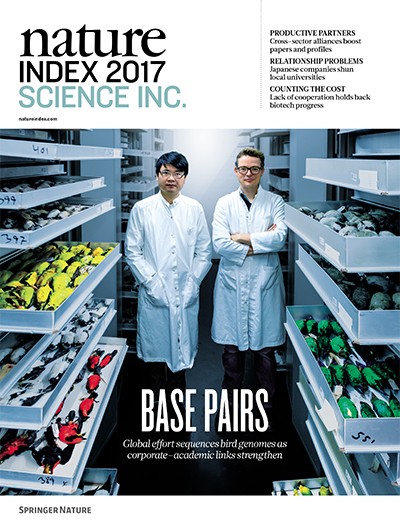The Nature Index is a database of author affiliations and institutional relationships. The index tracks contributions to articles published in a group of highly selective science journals, chosen by an independent group of active researchers.
The Nature Index provides absolute and fractional counts of publication productivity at the institutional and national level and, as such, is one indicator of global high-quality research output. Data in the Nature Index are updated regularly, with the most recent 12 months made available under a Creative Commons licence at natureindex.com. The database is compiled by Springer Nature. The list of journals tracked by the Nature Index will be extended in 2018.
Nature Index metrics
There are several measures provided by the Nature Index to track affiliation data. The simplest is the article count (AC). A country or institution is given an AC of 1 for each article that has at least one author from that country or institution. This is the case regardless of the number of authors an article has, and it means that the same article can contribute to the AC of multiple countries or institutions.
Part of Nature Index: Science Inc.
To get a sense of a country’s or institution’s contribution to an article, and to ensure they are not counted more than once, the Nature Index uses the fractional count (FC), which takes into account the share of authorship on each article.
The total FC available per paper is 1, which is shared among all authors under the assumption that each contributed equally. For instance, a paper with 10 authors means that each author receives an FC of 0.1. For authors who have joint affiliations, the individual FC is then split equally between each affiliation.
Another measure used is the weighted fractional count (WFC), which applies a weighting to the FC to adjust for the over-representation of papers in astronomy and astrophysics. Four journals tracked by the index in these disciplines publish approximately five times the number of papers relative to other disciplines. Therefore, although the data for astronomy and astrophysics are compiled in the same way as for other disciplines, articles from these journals are assigned one-fifth the weight of other articles (the FC is multiplied by 0.2 to derive the WFC).
The total FC or WFC for an institution is calculated by summing the FC or WFC for individual authors. The process is similar for countries, although complicated by the fact that some institutions have overseas labs that will be counted towards host country totals.The fourth metric is bilateral collaboration score (CS). A bilateral collaboration can be between any two institutions or countries co-authoring at least one paper in the journals tracked by the Nature Index. CS is derived by summing the FCs from papers with authors from both institutions. If institution A has co-authored a paper with another institution, then the collaboration score between A and B is the sum of the FC for A+B.
Every effort is made to count affiliations consistently, with a background of reasonable assumptions. For more on how the affiliation information is processed, visit natureindex.com.
The supplement
Nature Index 2017 Science Inc. is based on data from natureindex.com, covering articles published during five years from 1 January 2012 to 31 December 2016. The tables rank the top 100 corporate institutions by their cumulative WFC for 2012 to 2016. All output is attributed to the parent corporate entity, however, subsidiaries making a sizable contribution to the share of authorship are also listed. The tables also rank the top 100 bilateral collaborations between a corporate and an academic institution, measured by their cumulative CS for 2012–2016. Additional tables list the top 50 corporate institutions ranked by the number of academic institutions they have co-authored papers with in that period, as well as the top 50 academic institutions co-authoring papers with the largest number of corporate partners.

 Outsourcing discovery
Outsourcing discovery
 A firm shift
A firm shift
 Papers to patents
Papers to patents
 Industry links boost research output
Industry links boost research output
 Help wanted: industry seeks science allies
Help wanted: industry seeks science allies
 Lost opportunities
Lost opportunities
 In good company
In good company
 First among equals
First among equals
 Corporates make reluctant partners
Corporates make reluctant partners








